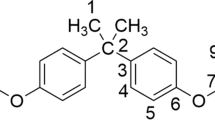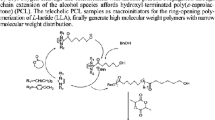Abstract
Unsaturated polyesters are of interest to scientists due to the presence of modifiable functional groups such as double and triple bonds. Active sites in the unsaturated polyesters are special options for drug delivery and biomedical applications. Click reaction is an attractive way to transfer drugs using unsaturated polyesters. In this study, low molecular weight unsaturated aliphatic polyesters containing internal triple and double bonds based on DL-malic acid have been synthesized. Oligoesters with different degrees of unsaturation have been synthesized by condensation polymerization of DL-malic acid and 1,4-butanediol, cis-2-butene-1,4-diol, 2-butyne-1,4-diol, and diol mixtures. Polymerization was performed in the absence of catalyst and at low temperature (130 °C) by bulk polymerization. FT-IR, 1H-NMR, 13C-NMR, and GPC analyses were used for the characterization of the synthesized structures. The thermal properties of the oligoesters were investigated using DSC analysis. The glass transition temperatures for unsaturated oligoesters containing single, double, and triple bonds were obtained -32 °C, -24 °C, and -38 °C, respectively. 1H-NMR spectra showed that DL-malic acid self-condensation reaction in the presence of 2-butyne-1,4-diol, cis-2-butene-1,4-diol, and 1,4-butanediol monomers occurs ~ 8%, ~ 5%, and ~ 4%, respectively. The HOMO–LUMO gap of DL-malic acid (7.0145 eV) and 2-butyne-1,4-diol (6.3905 eV) were calculated using DFT computational method at the base level of B3LYP/6-311G + (d,p). Oligoester containing internal triple bonds (2-butyne-1,4-diol (ByD50)) were crosslinked with 1,4-diazidobutane, and reaction progress was followed by FT-IR analysis. Unlike isocyanate curing, azide curing is not sensitive to moisture. It is hoped that unsaturated polyesters containing triple bonds can be used in click reactions and polyester modification. Oligoester contains a triple bond (ByD50) suitable for drug delivery. These oligoesters have a controllable degree of crosslinking and can be used to modify an oligoester with a controllable degree.













Similar content being viewed by others
References
Lenz RW (1993) Biodegradable polymers Adv Polym Sci 107:1–40
Albertsson AC, Varma IK (2003) Recent developments in ring opening polymerization of lactones for biomedical applications. Biomacromol 4:1466–1486
Margolis JM, Bell JP (1987) Advanced thermoset composites: Industrial and commercial applications. Van Nostrand Reinhold, New York
Amsden B (2007) Curable, biodegradable elastomers: emerging biomaterials for drug delivery and tissue engineering. Soft Matter 3:1335–1348
Coulembier O, Degée P, Hedrick JL, Dubois P (2006) From controlled ring-opening polymerization to biodegradable aliphatic polyester: Especially poly(β-malic acid) derivatives. Prog Polym Sci 31:723–747
Barrett DG, Yousaf MN (2009) Design and applications of biodegradable polyester tissue scaffolds based on endogenous monomers found in human metabolism. Molecules 14:4022–4050
Diciccio AM, Coates GW (2011) Ring-opening copolymerization of maleic anhydride with epoxides: A chain-growth approach to unsaturated polyesters. J Am Chem Soc 133:10724–10727
Atta AM, Nassar IF, Bedawy HM (2007) Unsaturated polyester resins based on rosin maleic anhydride adduct as corrosion protections of steel. React Funct Polym 67:617–626
Wu Y, Li K (2017) Replacement of styrene with acrylated epoxidized soybean oil in an unsaturated polyester resin from propylene glycol and maleic anhydride. J Appl Polym Sci 134:45056
Hu LF, Zhang CJ, Chen DJ, Cao XH, Yang JL, Zhang XH (2020) Synthesis of high-molecular-weight maleic anhydride-based polyesters with enhanced properties. ACS Appl Polym Mater 2:5817–5823
Liu Y, Deng K, Wang S, Xiao M, Han D, Meng Y (2015) A novel biodegradable polymeric surfactant synthesized from carbon dioxide, maleic anhydride and propylene epoxide. Polym Chem 6:2076–2083
Wan ZQ, Ren WM, Yang S, Li MR, Gu GG, Lu XB (2019) Reversible transformation between amorphous and crystalline states of unsaturated polyesters by cis–trans isomerization. Angew Chemie - Int Ed 58:17636–17640
Mer PK, Parsania PH (2011) Synthesis and thermal study of cured epoxy-acrylate-maleate, unsaturated polyester and their interpenetrating networks of varying compositions. Polym - Plast Technol Eng 50:282–287
He ZA, Blank WJ (2002) Picci ME (2002) A selective catalyst for two-component waterborne polyurethane coatings. J Coatings Technol 74930(74):31–36
Hsu Y-H, Dove AP, Becker ML (2021) Crosslinked internal alkyne-based stereo elastomers: polymers with tunable mechanical properties. Macromolecules 54:4649–4657
Cetin M, Esen C, Daglar O, Luleburgaz S, Hizal G, Durmaz H, Tunca U (2016) 1,3-Dipolar and Diels-Alder cycloaddition reactions on polyester backbones possessing internal electron-deficient alkyne moieties. Polym Chem 7:7094–7100
Silvers AL, Chang CC, Emrick T (2012) Functional aliphatic polyesters and nanoparticles prepared by organocatalysis and orthogonal grafting chemistry. J Polym Sci Part A Polym Chem 50:3517–3529
Chen M, Fan D, Liu S, Rao Z, Dong Y, Wang W, Chen H, Bai L, Cheng Z (2019) Fabrication of self-healing hydrogels with surface functionalized microcapsules from stellate mesoporous silica. Polym Chem 10:503–511
Döhler D, Michael P, Binder WH (2017) CuAAC-Based Click Chemistry in Self-Healing Polymers. Acc Chem Res 50:2610–2620
Pearson HA, Urban MW (2014) Simple click reactions on polymer surfaces leading to antimicrobial behavior. J Mater Chem B 2:2084–2087
Hilf J, Frey H (2013) Propargyl-functional aliphatic polycarbonate obtained from carbon dioxide and glycidyl propargyl ether. Macromol Rapid Commun 34:1395–1400
Stuck M, Krenz I, Schulze Kökelsum B, Boye S, Voit B, Lorenz R (2021) Improving glass transition temperature of unsaturated polyester thermosets: Conventional unsaturated polyester resins. J Appl Polym Sci 138:49825
Qin A, Lam JWY, Tang BZ (2010) Click polymerization: Progresses, challenges, and opportunities. Macromolecules 43:8693–8702
Wu WX, Wang N, Liu BY, Deng QF, Yu XQ (2014) Lipase-catalyzed synthesis of azido-functionalized aliphatic polyesters towards acid-degradable amphiphilic graft copolymers. Soft Matter 10:1199–1213
Naolou T, Busse K, Kressler J (2010) Synthesis of well-defined graft copolymers by combination of enzymatic polycondensation and “Click” chemistry. Biomacromol 11:3660–3667
Riva R, Schmeits S, Stoffelbach F, Jérôme C, Jérôme, R, Lecomte P (2005) Combination of ring-opening polymerization and “click” chemistry towards functionalization of aliphatic polyesters. Chem Commun 5334–5336
Lecomte P, Riva R, Jérôme C, Jérôme R (2008) Macromolecular engineering of biodegradable polyesters by ring-opening polymerization and “click” chemistry. Macromol Rapid Commun 29:982–997
Kantheti S, Narayan R, Raju KVSN (2013) Development of moisture cure polyurethane-urea coatings using 1,2,3-triazole core hyperbranched es. J Coatings Technol Res 10:609–619
Malik M, Choudhary V, Varma IK (2007) Current status of unsaturated polyester resins. J Macromol Sci Polymer Rev 40:139–165
Marvel CS, Johnson JH (1950) The effect of an acetylenic unit on the physical properties of polyesters and polyurethans. J Am Chem Soc 72:1674–1677
Feit B-A, Raucher D, Zilkha A (1965) Acetylenic polyesters J Appl Polym Sci 9:2379–2391
Yoo Y, Ko M-S, Han S-I, Kim TY, Im S (1998) Kim DK (1998) Degradation and physical properties of aliphatic copolyesters derived from mixed diols. Polym J 307(30):538–545
Denchev Z, Dudevski I, Petrova J, Fakirov S (1995) A triple-bonds-containing poly(ether/ester): synthesis, characterization and cross-polymerization. Macromol Chem Phys 196:1593–1606
Kricheldorf HR, Gao Q, Buzin P, Schwarz G (2008) Aliphatic polyesters of butyne-1,4-diol. Macromol Chem Phys 209:385–392
Yan Y, Siegwart DJ (2014) Scalable synthesis and derivation of functional polyesters bearing ene and epoxide side chains. Polym Chem 5:1362–1371
Hahn C, Wesselbaum S, Keul H, Möller M (2013) OH-functional polyesters based on malic acid: Influence of the OH-groups onto the thermal properties. Eur Polym J 49:217–227
Wang H, Liu K, Chen X, Wang M (2021) Thermal properties and enzymatic degradation of PBS copolyesters containing dl-malic acid units. Chemosphere 272:129543
Gunay US, Cetin M, Daglar O, Hizal G, Tunca U, Durmaz H (2018) Ultrafast and efficient aza- and thiol-Michael reactions on a polyester scaffold with internal electron deficient triple bonds. Polym Chem 9:3037–3054
Tang T, Moyori T, Takasu A (2013) Isomerization-free polycondensations of cyclic anhydrides with diols and preparation of polyester gels containing cis or trans carbon double bonds via photo-cross-linking and isomerization in the gels. Macromolecules 46:5464–5472
Wang D, Chen S, Zhao J, Zhang Z (2020) Synthesis and characterization of self-healing cross-linked non-isocyanate polyurethanes based on Diels-Alder reaction with unsaturated polyester. Mater Today Commun 23:101138
Luleburgaz S, Hizal G, Durmaz H, Tunca U (2017) Modification of electron deficient polyester via Huisgen/Passerini sequence. Polymer (Guildf) 127:45–51
Shi W, Rånby B (1994) UV curing of composites based on modified unsaturated polyester. J Appl Polym Sci 51:1129–1139
Yang Y-S, Suspene L (1991) Curing of unsaturated polyester resins: Viscosity studies and simulations in pre-gel state. Polym Eng Sci 31:321–332
Kantheti S, Sarath PS, Narayan R, Raju KVSN (2013) Synthesis and characterization of triazole rich polyether polyols using click chemistry for highly branched polyurethanes. React Funct Polym 73:1597–1605
Thomas JR, Liu X, Hergenrother PJ (2005) Size-specific ligands for RNA hairpin loops. J Am Chem Soc 127:12434–12435
Kolb HC, Finn MG, Sharpless KB (2001) Click chemistry: diverse chemical function from a few good reactions. Angew Chem Int Ed 40:2004–2021
Trivedi BC, Culbertson BM (1982) Maleic Anhydride in Condensation Polymers. In: Maleic anhydride Springer, Boston, MA
Kajiyama T, Taguchi T, Kobayashi H, Kataoka K, Tanaka J (2003) Synthesis of high molecular weight poly(α, β-malic acid) for biomedical use by direct polycondensation. Polym Degrad Stab 81:525–530
Qiu Y, Wanyan Q, Xie W, Wang Z, Chen M, Wu D (2019) Green and biomass-derived materials with controllable shape memory transition temperatures based on cross-linked Poly(l-malic acid). Polymer (Guildf) 180:121733
Somdee P, Lassú-Kuknyó T, Kónya C, Szabó T, Marossy K (2019) Thermal analysis of polyurethane elastomers matrix with different chain extender contents for thermal conductive application. J Therm Anal Calorim 138:1003–1010
Sahoo S, Kalita H, Mohanty S, Nayak SK (2017) Meticulous study on curing kinetics of green polyurethane-clay nanocomposite adhesive derived from plant oil: Evaluation of decomposition activation energy using TGA analysis. J Macromol Sci A 54:819–826
Hwang SW, Shin MJ, Shin JS, Kim CH (2017) Dielectric responses of polyurethane films related to temperature and frequency. Bull Korean Chem Soc 38:561–569
Król P, Król B, Pielichowska K, Špírková M (2015) Composites prepared from the waterborne polyurethane cationomers—modified graphene. Part I. Synthesis, structure, and physicochemical properties. Colloid Polym Sci 293:421–431
El-Mansy MAM, El-Nahass MM, Khusayfan NM, El-Menyawy EM (2013) DFT approach for FT-IR spectra and HOMO–LUMO energy gap for N-(p-dimethylaminobenzylidene)-p-nitroaniline (DBN). Spectrochim Acta Part A Mol Biomol Spectrosc 111:217–222
Huisgen R (1963) 1.3-Dipolare cycloadditionen rückschau und ausblick. Angew Chemie 75:604–637
Huisgen R (1968) Cycloadditions — definition, classification, and characterization. Angew Chemie Int Ed English 7:321–328
Agard NJ, Prescher JA, Bertozzi CR (2004) A strain-promoted [3 + 2] azide−alkyne Cycloaddition for covalent modification of biomolecules in living systems. J Am Chem Soc 126:15046–15047
Acknowledgements
The authors are grateful to the Malek Ashtar University of Technology for supporting this work.
Author information
Authors and Affiliations
Corresponding author
Ethics declarations
Competing interest
The authors declare that they have no known competing financial interests or personal relationships that could have appeared to influence the work reported in this paper.
Additional information
Publisher's Note
Springer Nature remains neutral with regard to jurisdictional claims in published maps and institutional affiliations.
Supplementary Information
Below is the link to the electronic supplementary material.
Rights and permissions
Springer Nature or its licensor holds exclusive rights to this article under a publishing agreement with the author(s) or other rightsholder(s); author self-archiving of the accepted manuscript version of this article is solely governed by the terms of such publishing agreement and applicable law.
About this article
Cite this article
Fallah, D., Fareghi-Alamdari, R. & Tavangar, S. Unsaturated oligoesters containing internal triple and double bonds based on DL-malic acid: synthesis, characterization and study of crosslinking via click reaction. J Polym Res 29, 458 (2022). https://doi.org/10.1007/s10965-022-03218-9
Received:
Accepted:
Published:
DOI: https://doi.org/10.1007/s10965-022-03218-9




